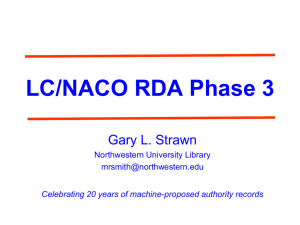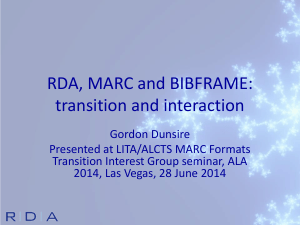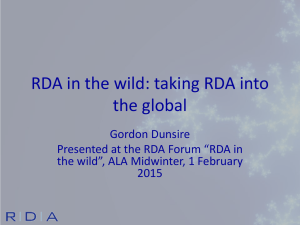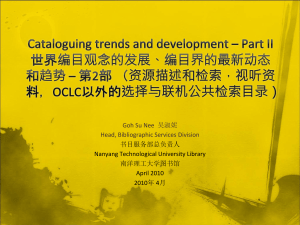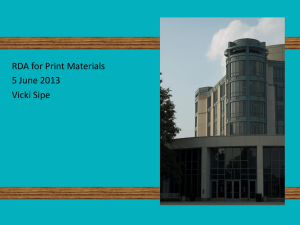RDA for non-cataloguers presentation
advertisement
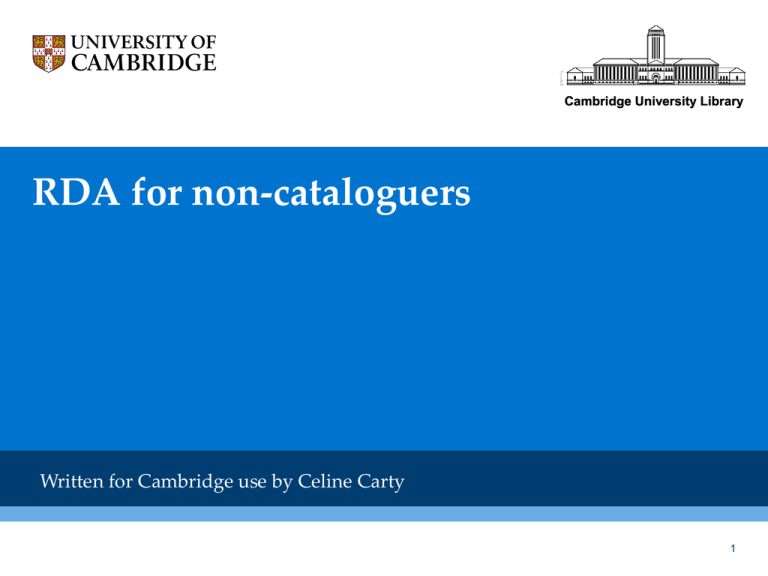
Cambridge University Library RDA for non-cataloguers Written for Cambridge use by Celine Carty 1 Overview What is RDA? Why do we need RDA? What does this mean in Cambridge? How to recognise RDA records Looking at RDA records RDA & discovery 2 What is RDA? The new cataloguing standard replacing AACR2 (AngloAmerican Cataloguing Rules, 2nd edition) 3 Why a new standard? It’s about time! 1978 Slide by Chris Oliver, used with permission Problems with AACR2 Written in the context of card catalogues • abbreviations • limited number of contributors that could be included Inadequate rules for the description of new types of resources, especially electronic resources Lack of a theoretical framework to act as a reference point when dealing with new situations The road to RDA 2004 Work starts on AACR3 2005 -> Resource Description and Access 2009 RDA text is completed 2010-2011 US National Test of RDA 2012 Decision announced by Library of Congress, British Library, National Library of Australia and others 31st March 2013 RDA Implementation 6 Continuity from AACR2 to RDA • continue to record the title • continue to record the edition • continue to record the date of publication But … • new vocabulary • new way of thinking about how we do these steps • new theoretical model Theoretical underpinning of RDA RDA is based on a combination of: FRBR (Functional Requirements for Bibliographic Records) & FRAD (Functional Requirements for Authority Data) ICP (IFLA’s Statement of International Cataloguing Principles) Cataloguing decisions focus on the user tasks of FRBR: Find, Identify, Select, Obtain 8 RDA in Cambridge Implement RDA in all original cataloguing of print monographs, integrating resources and serials in 2013 31st March cambrdgedb database (UL, CSL, Medical, Moore & Squire Law Libraries) 1st October all other Cambridge libraries Other formats (maps, music, electronic resources, etc.) will move to RDA during the academic year 2013-14 9 What does RDA implementation mean? RDA is specifically designed so that RDA records are compatible with AACR2 records, and can co-exist in the same database No plans for manual conversion to RDA of: our existing AACR2 records full-level AACR2 records downloaded in copy-cataloguing workflows, even after Mar. 2013 Many global updates will be made using batch processes, e.g. amendments to the authority forms of names 10 UL & cambrdgedb Training for UL, CSL, Medical, Moore & Squire Law Library staff started December 2012 Around 75 staff, including all who do any cataloguing at all in the cambrdgedb database Formal training (minimum 20hrs) Jan-March 2013 Ongoing support from April onwards Similar programme for other Cambridge libraries (all other Voyager databases) in June-Sept 2013 11 RDA is here – what does this mean? Even when cataloguing in RDA, still using: • Voyager • Newton/LibrarySearch/LibrarySearch+ • MARC21 encoding • Same subject headings, same classification 12 RDA is already here Already have nearly 4,000 RDA in cambrdgedb Almost 100,000 RDA name authorities already in the database (with more coming) Some suppliers already sending RDA records BL contributing them to BNB and creating CIP records in RDA Voyager, Newton, LibrarySearch and LibrarySearch+ coping fine - some minor display issues will be fixed with next Voyager upgrade, later this year 13 RDA spotting in the wild In MARC records: 040 containing $e rda Additional clues: Leader “Cataloging form” = i 33X ... $2 rda... 15 Identifying RDA in MARC – the Leader 16 17 Relationship designators Relationship designators in 1XX/7XX fields (“Main author” and “other entries” in Newton) • these follow authorised access points (headings) for persons, corporate bodies, and families • they can relate to various levels of involvement – eg creator (author, composer, etc) and contributor (editor, illustrator, etc) – and use a controlled list of vocabulary 18 Transcription of information RDA emphasises transcription from the resource, so we see fuller data in title, statement of responsibility and other areas. Introduction to the physics of waves / Tim Freegarde, University of Southampton. 19 RDA and AACR2’s “rule of three” Under AACR2, the “rule of three“ meant that: • if there were more than three authors/editors/etc, the cataloguer transcribed only the first and gave an access point only to that first name The “rule of three” disappears under RDA • the cataloguer now transcribes all names unless unduly onerous and provides access points for all those names – again, unless unduly onerous 20 Rule of three example 21 Publication information AACR2 included all information about publication, manufacture, distribution and copyright in one field RDA separates out information about publication, manufacture, distribution and copyright Now use copyright symbol © instead of letter “c” 22 Abbreviations and RDA RDA is a largely abbreviation-free standard • abbreviations which RDA now spells out include: • p. ( pages); • ill. ( illustrations); • ports. ( portraits); • v. ( volume/volumes) • exception: cm (because it’s considered a symbol) • NB: abbreviations are used when they appear on the resource itself 23 Latin terms and RDA RDA moves away from Latin, preferring English instead Latin terms which are not used in RDA include: • et al. ( and x others); • s.l.; s.n.; n.d. ( place of publication not identified; publisher not identified; date of publication not identified); • ca. ( approximately) NB: Latin terms are used when they appear on the resource itself 24 Goodbye GMD GMD (General Material Designation) in AACR2, bracketed information in the title that conveys the type of material (for non-print resources) [electronic resource], [sound recording], [videorecording] Confusing combination of carrier and content information 25 26 27 Changes to the database Various settings have been changed in Voyager already to incorporate the RDA changes New tag tables in the Cataloguing module, changes to the display mapping in Newton, etc. Voyager upgrade to accommodate the final RDA changes Display and indexing under ongoing review 28 Changes to authority records Lots of changes for RDA done as global updates to authority records, files released in batches to libraries Global changes underway now (March 2013): • Expand abbreviations (arr., acc., unacc., Dept., cent., fl., ca.) • Replace “b.” and “d.” in dates with hyphens • Change “violincello” to “cello” in headings • Changes to Bible (O.T. and N.T.) and Koran headings • Change Koran to Qur’an 29 Changes to the authority file - 2 During these automated changes, please be patient! ~30,000 updated authority records per day There will be a delay in dealing with the large number of updated records locally, but they are being done. There may be a slight delay until all catalogue records containing a particular name are all changed to the RDA form, but hopefully the effects of this will be minimal 30 Getting books to the shelf While everyone is learning something new, cataloguing will inevitably take a bit longer However, workflows have been adapted as much as possible to ensure that the number of books reaching the shelf each week remains roughly the same We aim to minimise the impact on users as much as possible Urgents and reader requests will still be processed in the same timeframe 31 RDA … takes us from where we are moves us to a new track puts us on the right track for the next part of the journey Slide by Chris Oliver, used with permission Why is RDA important? To get bibliographic data out of the library silo • visible on the web • interacting with the data of other metadata communities Clearer language for library users Easier for computers to manipulate Well-defined and structured data elements Open up our world to others who want to use our data Move away from using MARC (a library-only standard) Benefits of RDA Now Future • designed to work in current catalogues • ready to take advantage of new database structures • compatible with AACR2 records • function in the semantic web, linked data environment • co-exist with AACR2 records in the same databases • visible in the web alongside other types of metadata Slide by Chris Oliver, used with permission http://www.lib.cam.ac.uk/libraries/login/RDA/ 35 More information The slides for this presentation, along with lots of other RDA resources and documentation, are available from: http://www.lib.cam.ac.uk/libraries/login/RDA/docs.html 36

